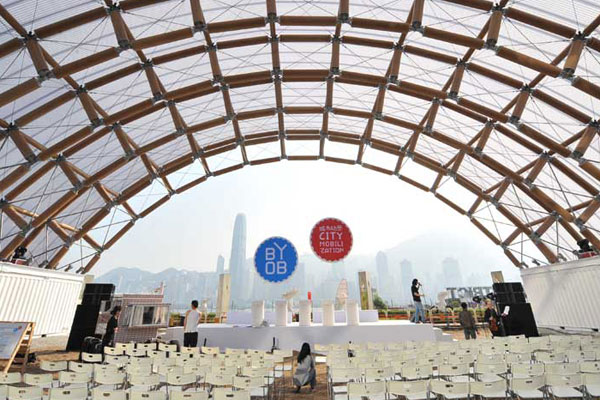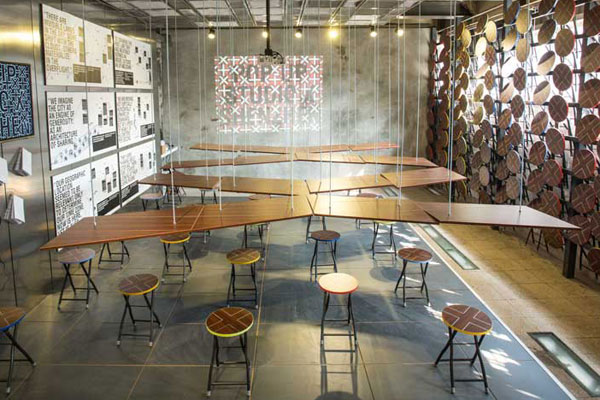Marisa Yiu and Eric Schuldenfrei of ESKYIU epitomise a rare breed of architects who combine intellectual ambition with a socially-conscious mind, writes Christie Lee.

January 25th, 2015
Given the amount of ink lavished on extravagantly designed ‘iconic’ buildings in the last decade or so, you’d think that modern architecture is all about show (not that they don’t have their own architectural merits of course). ESKYIU, the Hong Kong-based multidisciplinary architectural firm set up by Marisa Yiu and Eric Schuldenfrei in 2005, wants to change that with technologically-driven projects that are sense-stimulating and thought- provoking. “Linear Landscapes” was conceived to provide a possible solution to the lack of vegetation in the Hong Kong urban landscape, while “Industrial Forest” is at once an examination of how an artificial natural habitat can at once reflect and fool nature.
How receptive is the Hong Kong public to the idea of ‘green architecture’?
Eric Schuldenfrei (ES): Not very. In a city like Singapore, which is equally restrictive in some sense, there seems to be a greater understanding that green architecture is something important, which is reason for the proliferation of green roofs and surfaces. We need to think about green architecture not just from a sustainability point of view, but also from that of aesthetics. In Hong Kong, urban dwellers are very disconnected from nature. All they see are reflections of the sky from concrete or other applied surfaces.

Bring Your Own Biennale: City Mobilization at Hong Kong-Shenzhen Bi-city Biennale of Urbanism Architecture 2009
Marisa Yiu (MY): The best kind of ‘green architecture’ is the kind that doesn’t say it is ‘green’. Take the paper-tube canopy that Shigeru Ban designed for our main pavilion at the 2009 Hong Kong-Shenzhen Bi-city Biennale of Urbanism Architecture as an example. It’s not intrusive, yet it’s highly functional. What we’re trying to do with all our designs is to make a statement in a playful way.

POP-UP Studio-X at Bi-city Biennale of Urbanism Architecture 2013
What inspired your curatorial direction for the 2009 Hong Kong-Shenzhen Bi-city Biennale of Urbanism Architecture?
MY: We basically had a Pun Choi feast where we invited hundreds of people to dine on site. We organised Cantonese-speaking cultural tours. We wanted the Biennale to be much more than about the architect.
ES: We also want to bring out the divide that seems to exist in Hong Kong society, the divide that dictates who has access to the city. In the past, the only people who would visit the Biennale were architects, urban planners and landscape designers, but we wanted to use the site in a different way.
Who are your inspirations?
MY: Elizabeth Diller, who taught at Princeton when I was a graduate student there. Mark Wigley, who headed POP-UP Studio-X Shenzhen. The architects we’re inspired by all operate in a multidisciplinary manner. We also love artists like Sophie Calle. Eric can tell you about his obsession with the Eameses…
ES: Ah yes. The irony is that while everyone knows the Eames chair, their films are less well-known. Not only did The Powers of Ten films mark a shift in western thinking during the 1950s, they were also instrumental in the educational realm. In terms of how we relate to them, we’ve never seen the work we produce as a mere object – there’s always another layer of meaning behind it.
What is the role of the 21st century architect?
MY: Public intellectuals. Rather than building for building’s sake, the 21st century architect should build something that would benefit the community. There also needs to be a greater synergy between architects and urban planners.
ES: The question we’re always asking ourselves is: how do we as architects turn the spectator into an active participant? We don’t see the things we build as a moment idealised in time, but rather something that will be transformed overtime.
Most of your projects are transient in nature. How does this ephemerality affect your design approach?
MY: It’s definitely a thread that runs through a lot of our projects. The Industrial Forest at Spring Workshop for example.
ES: What’s interesting about that particular project was that while we called it ‘Industrial Forest’, the ‘hums’ produced whenever the wind brushes against the aluminium filaments resembles the sounds in a real forest.
MY: It was also very much about the psychology of space. We had kids who tore through it, and big-shot museum curators who treaded tentatively through it. A bird started to build her nest on it, while a cobweb grew on one of the filaments. Besides being a case of artificial nature tricking nature, these developments also challenge our understanding of biodiversity. It’s also a comment on the lack of biodiversity in the area. After all, Wong Chuk Hang was so named because the area used to be rife with yellow bamboos.
ESKYIU
eskyiu.com
A searchable and comprehensive guide for specifying leading products and their suppliers
Keep up to date with the latest and greatest from our industry BFF's!

In the pursuit of an uplifting synergy between the inner world and the surrounding environment, internationally acclaimed Interior Architect and Designer Lorena Gaxiola transform the vibration of the auspicious number ‘8’ into mesmerising artistry alongside the Feltex design team, brought to you by GH Commercial.

Suitable for applications ranging from schools and retail outlets to computer rooms and X-ray suites, Palettone comes in two varieties and a choice of more than fifty colours.

Sub-Zero and Wolf’s prestigious Kitchen Design Contest (KDC) has celebrated the very best in kitchen innovation and aesthetics for three decades now. Recognising premier kitchen design professionals from around the globe, the KDC facilitates innovation, style and functionality that pushes boundaries.

The auditorium was full, the vibe electric and the winners truly outstanding last night at the INDE.Awards Gala. Scroll the Indo Pacific’s most outstanding projects and people, here.

On the evening of 4 August, the INDE.Awards will put the spotlight on four outstanding individuals – people who have attained great success and respect in the sphere of architecture and design. Meet Nonda Katsalidis, Meryl hare, Nathan Yong and Marisa Yiu.
The internet never sleeps! Here's the stuff you might have missed

Landing in the city’s financial district for the first time, The Sebel Sydney Martin Place has had its modern interiors completed by Stack Studio.

Eccentricity and refinement blend at Giant Steps Wines’ new Tasting Room – a picture-perfect place for guests to wine down.